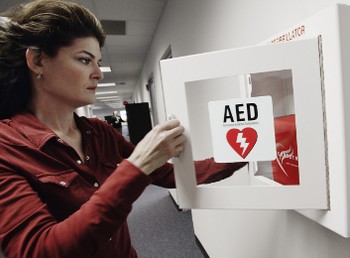If someone is having a heart attack, how quickly they receive help can make the difference between life and death. In the past, the only way a friend or family member could help someone having a heart attack was to call 911 until medical help arrived.
The problem with CPR is that it’s easy to make mistakes, and not everyone has the necessary training. Today, we have a device called an automated external defibrillator (AED) that can really increase your chances of survival, without having to rely on CPR.
What are AEDs?
Have you ever seen a hospital show where someone has a heart attack and they have to pull out this big electric paddle, adjust the voltage, and shock the patient back to life? It’s an external defibrillator. A automatic external defibrillators are similar except the machine adjusts the voltage; a number of AED brand will even throw a surprise for you. AEDs are designed so that non-professionals can provide life-saving care at home, or in a public place, such as a mall.
How AEDs Work:
When someone has a heart attack, the heart doesn’t always stop beating completely. Sometimes it becomes something called fibrillation, where it vibrates instead of beating. The AED delivers an electric shock, directly to the heart, which defibrillates the heart and returns it to a healthy rhythm.
The AED can actually detect if the heart is in fibrillation and, if so, deliver the required shock. If the heart does not respond to the first shock, the AED will adjust itself and deliver another shock until the heart responds or has delivered the maximum number of shocks.
The AED will only work on a fibrillated heart. It won’t work if the person has a normal heartbeat, or if the pads can’t detect a heartbeat at all, so one scene in Breaking Bad really can’t happen in real life.
The steps for using the AED are very simple and must be printed on the device. But we can also provide basic instructions here, to give you an idea of the sequence of events.
If someone is having a heart attack:
- Call 911 to make sure emergency personnel are on their way. If possible, have someone else do everything while you get the AED. That way they can stay connected and you can focus on using your device. If you are alone, stay connected to 911 while you are using the AED, unless they tell you to hang up.
- Carefully roll the person onto their back, if they are not already there. Be sure to support his head and neck to reduce the risk of injury;
- Undress to expose chest. If necessary, trim the shirt and cut the bra;
- Open the AED and follow the instructions for placing the chest pad. If the person has a lot of chest hair, use the disposable razor that came with the AED to remove the hair before applying the dressing;
- Turn on the AED and let it detect the heart rhythm;
- The AED will notify you if a shock is needed and give you instructions on what to do.
Do not use the AED on people who have pacemakers or implanted defibrillators. Avoid placing the pads directly into the metal piercings. Do not use an AED on an infant unless it is designed for that purpose. Instead you should perform infant CPR until help arrives.








